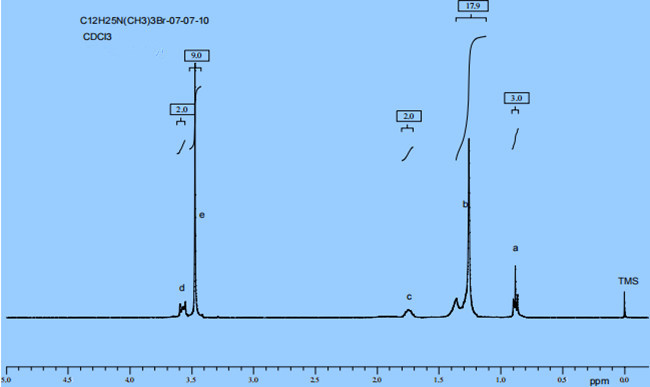Nuclear Magnetic Resonance Spectroscopy Analysis of Dodecyl Trimethyl Ammonium Bromide
Sep 15, 2021The nuclear magnetic resonance spectrometer is a high-precision instrument with very high detection sensitivity, and is widely used in nuclear magnetic resonance spectroscopy. In addition to determining the structure of drugs and organic chemicals, it has also become an important means for quantitative analysis of drugs and organic chemicals. The use of nuclear magnetic resonance spectroscopy can easily and accurately analyze the purity of large molecules or salt organic substances, with sensitivity comparable to conventional analytical methods such as gas chromatography and titration analysis, but the cost is high. We use nuclear magnetic resonance technology to determine the purity of Dodecyl trimethyl ammonium bromide.
♠ Prepare samples: Place 10-15 mg of the sample in a nuclear magnetic tube, add 0.5 mL of deuterated bromoform (CDCl3), and shake to dissolve.If it cannot be completely dissolved, heat the nuclear magnetic tube appropriately.
♠ Measurement process: Using tetramethylsilicon as the internal standard for chemical shift, it was measured on a nuclear magnetic resonance instrument. Most nuclear magnetic resonance machines have specialized. Person in charge, the laboratory technician can operate according to conventional parameters.

Figure 1
♠ Purity analysis: In Figure 1, there are no significant impurity peaks observed in the range of 2.0 to 3.0 ppm, indicating that the levels of free amines and amine salts in our product are below the detection limit of the nuclear magnetic resonance spectrometer (<0.1%). If there are other organic impurities present in the product, the same principle applies, and other peaks would appear at corresponding positions. Therefore, by analyzing the position (chemical shift) and the peak areas of the spectrum peaks, it is also possible to determine whether there is any residual organic solvent. From Figure 1, it can be observed that apart from the five groups corresponding to Dodecyltrimethylammonium bromide spectrum peaks, there are no other peaks present, indicating the absence of residual organic solvents in the product.